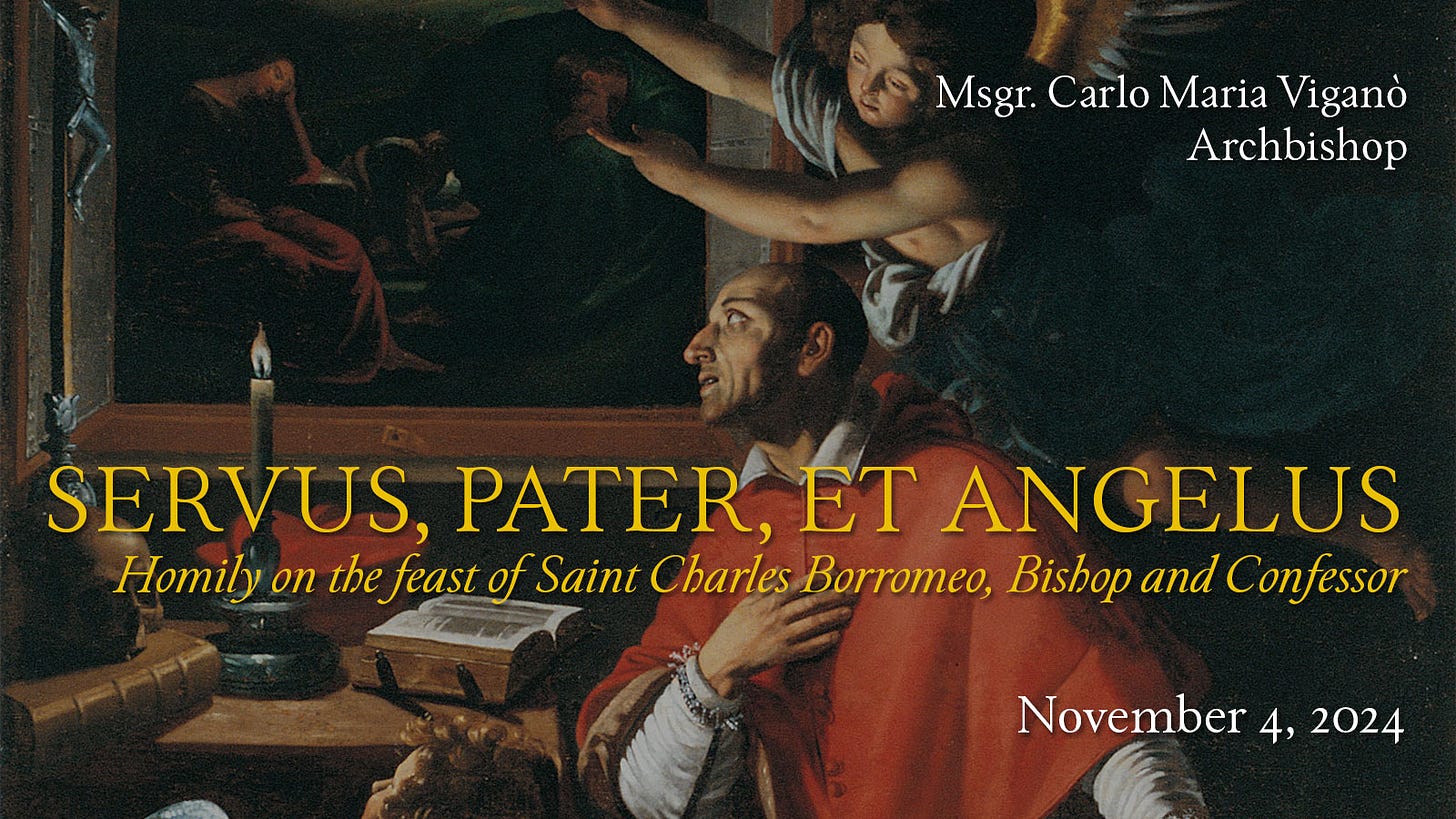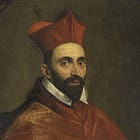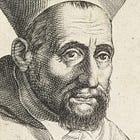+Viganò: True pastors, false hirelings, and St Charles Borromeo
Archbishop Carlo Maria Viganò presents St Charles Borromeo as the model and example for bishops and pastors—and shows how far from this the false hirelings of the conciliar/synodal church really are.

Editors’ Notes
In his sermon for the Feast of the Exaltation of the Holy Cross, Archbishop Viganò…
Shows the similarities of St Charles Borremeo’s situation and ours
Compares and contrasts true pastors like Borromeo and the hirelings of the Conciliar/Synodal Church
Reveals that he actually uses the traditional Ambrosian rite of Mass.
Archbishop Viganò specifically shows how St Charles provides an example for pastors of the Church today.
We have added some links to articles which we believe give some further context to the ideas mentioned by Archbishop Viganò, as well as some headings line breaks to make the text easier to read online.
Servus, Pater, et Angelus
Mgr. Carlo Maria Viganò
Homily on the Feast of
St Charles Borromeo
Bishop and Confessor
4 November 2024
Sacerdos et Pontifex,
et virtutum opifex.
The life of the saint
Four hundred and forty years ago, on November 3, 1584, St. Charles Borromeo returned his soul to God at the age of forty-six. He belonged to the ancient and noble Paduan family of the Buon Romeo, who had their castle and county in Arona, on Lago Maggiore.
Tonsured at the age of seven, beginning in November 1552 he was a law student in Pavia, becoming a doctor in utroque jure in 1559. Devoted to the Prelature as a cadet, he began his ecclesiastical career at the age of twenty-two, when his uncle Giovanni Angelo de Medici—elected Pope with the name of Pius IV—conferred on him important positions: commendatory Abbot of a dozen abbeys, Legate of the Romagna, protector of the Kingdom of Portugal and the Netherlands, Archpriest of Santa Maria Maggiore, Grand Penitentiary, administrator of the Diocese of Milan, and then Secretary of State.
The life of the young Charles was dedicated to the service of the Church and the Papacy, so that the surname Buon Romeo seems to perfectly express the faith of the pilgrim who sets his eyes on the Rome of the Martyrs, the Rome of Peter and Paul, and the Rome of the great Catholic Reformation and the Council of Trent.
His ideals for the diocesan structure
His presbyteral ideal consisted in creating a body, distinct from others, whose parts connected organically and all obeyed one head. “You are my eyes, my ears, my hands,” Charles said to his priests: this metaphor had a literal value in him.
He founded the Oblates of St. Ambrose, taking as an example the constitutions of the Oratorians of St. Philip Neri. His congregation constituted a body of volunteers at the disposal of the Bishop, well-trained and disciplined, willing to take on difficult and demanding tasks.
The Oblates were used for the direction of Seminaries and, above all, for the preaching of missions to the people. Their charism, in which many Ignatian elements can be seen, consisted in keeping alive a spirituality marked by belonging to the diocesan clergy, by the vow of obedience to the Bishop, and by the safeguarding of the Ambrosian elements proper to the Church of Milan.
Similarities and differences between his time and ours
The situation of the Church in the sixteenth century was not the best.
The moral decay of the laity and the clergy due to the secularization induced by the culture of the Renaissance—which had a clear neo-pagan, kabbalistic and esoteric orientation in the ruling classes – was accompanied by a poor doctrinal formation.
The corruption of the Roman Curia, used as a pretext by heretics to attack the Papacy, made the government of the Church very difficult and the ministry of Pastors very ineffective.
The Council of Trent, in which Borromeo actively collaborated, managed to heal this ecclesial crisis with a great reform that gave new impetus to the whole of society, not only from a religious point of view, but also from a moral, cultural, artistic, and economic point of view. It began the foundation of Seminaries, thanks to which clerics were prepared to face priestly commitments in the various ecclesiastical disciplines.
In short, the Popes and Bishops of Trent behaved in a way diametrically opposed to what the Popes and Bishops of the Second Vatican Council did, who used “their council” not to combat the new errors, but to introduce them into the sacred precinct; not to restore the sacred Liturgy, but to demolish it; not to gather the Catholic flock around their Pastors, but to disperse it and abandon it to the wolves.
Conciliar/Synodal Church’s rejection of his legacy
If Saint Charles was inflamed with love for the Mass and for the Most Holy Eucharist—his homilies to the people and his meditations to the clergy on this theme are famous—the Bishops three centuries later trampled on his legacy, weakening precisely those two praesidia of Catholic orthodoxy that were once again threatened by the neo-Protestantism the Bishops promoted.
If Saint Charles was a devout supporter of Marian devotion, whose strong anti-Protestant value he understood, the supporters of Vatican II tried in every way to weaken it, culpably favoring “ecumenical dialogue” instead.
And the Seminaries and Universities that Borromeo founded for the defense of the Faith and the discipline of the Clergy became lairs of rebels and fornicators three hundred years later.
And this did not happen by chance, but by the deliberate and wicked desire to destroy that model that had proved to be indisputably effective, so that the Catholic Church would find herself once again in the state that she was, and even worse, than in the sixteenth century.
The difference between the Church that produced Trent and that which produced the Conciliar/Synodal revolution
The model of the landed assets owned by the Borromeo family and its genuinely Lombard spirit inspired St. Charles in the government of the Church. His pastoral economy bore the mark and consisted in distributing “land” to good tenants—the Pastors—visiting and controlling them. It was geographical and territorial, aimed at a better yield in terms of crops and the “fruits” of the land—the parishes—entrusted to zealous bursars.
The documents approved by the Council of Trent in 1562-63 presented the ideal of the eminent dignity and duties of the Bishop, dedicated to a higher ambition and linked to the urgency of the times.
Throughout his life, the Canones reformationis generalis of Trent had the value of a decisive revelation for Saint Charles. He assisted and collaborated in the production of this image of the Bishop, a man of action: “a man of fruit and not of flower, of deeds and not of words” in the words of Cardinal Seripando. Borromeo could not conceive of the Faith without works—a fundamental Tridentine doctrine, denied by the sola fides of the Protestants—and his life was a monument to pastoral action, nourished by solid spirituality and a great love for the people, for the poor, for the needy.
In this too, significantly, his example is very eloquent: his commitment to the care of plague-stricken during the plague that struck Milan in 1576-1577 led him to call penitential processions and to visit and personally receive the sick in the infirmary.
Today’s timid courtiers, sons of Vatican II, who a few years ago holed up in their Curia and even forbade the celebration of Mass during the pandemic farce, should blush with shame before the zeal of Saint Charles and his Clergy.
Borromeo as a true shepherd
A rule given to priests by the Council of Trent was: Se componere (Conc. Trid., VIII, p. 965), conform to the role, transform yourself in accord with the letter:
“It is so much my desire that it is now expected to be fulfilled, since this Holy Council will be confirmed in conformity with the need that the whole of Christianity has for it and no longer to dispute.”
Borromeo was not a theologian, nor a great disputator—which is why we do not see him counted among the Doctors of the Church—but a pastor, that is, a faithful executor.
“We would like to have diligently observed all that has been prescribed in all previous synods,” he said in 1584.
And again: “The life of a Bishop must be regulated […] solely according to the laws of ecclesiastical discipline.”
What an abyss, dear brothers, separates this race of holy prelates from those who have taken their place today! The obedience of the former has turned into the rebellion of the latter, poverty has transformed into lust for goods and power, chastity into vices and fornication, fidelity to the Magisterium into the ostentatious encouragement of heresy.
Implementation of Tridentine reform
Saint Charles also knew how to choose his collaborators, often taking them away from other dioceses, to the point that Saint Philip Neri, with the usual confidence between saints, calls him the “thief of bishops.”
When he became Archbishop of Milan, in 1564, he convened the diocesan Synod and gathered his twelve hundred priests to dictate to them a program for the application of the Tridentine decrees and a series of disciplinary measures (residence, reduction of the number of benefices, morality, ecclesiastical studies, pastoral practices) that did not fail to raise protests, especially when—with a brilliant intuition—he applied financial fines to disobedient clerics.
He entrusted the Ambrosian Seminary to the Jesuits, continuing to watch over and supervise the lives of the young people who were formed there in detail. The institution of the Pastoral Visit was an instrument that allowed Saint Charles to personally stay in touch with the life of the parishes, ensuring that the Decrees of the Council of Trent were fully applied.
When his uncle Pius IV de Medici died in 1565 and Pius V Ghislieri was elected in 1566, Borromeo devoted himself entirely to the cura animarum in his diocese. Here he strenuously fought the spread of Lutheran, Calvinist, Zwinglian, and finally Anabaptist heresies that found followers among the Augustinians, the Franciscans, and the Dominicans. But against rebellions, sects, carnivals, and fraudulent bribery—his main opponents—Saint Charles preferred the rigors of preaching or ecclesiastical law, rather than seeking the interference of the temporal governing power, which at the time was under Spanish domination.
Reform of clerical life
Strengthened by the example of his illustrious predecessor Saint Ambrose, he never bowed to the excessive power of the civil authority, on which he did not hesitate to impose even excommunication. Borromeo thus created an elite body, thanks to model institutions in which all the methods applied in the Diocese could function in an exemplary way:
“Nihil magis necessarium aut salutare videri ad restituendum veterum ecclesiasticorum disciplinam quam Seminarii institutionem.”
(Nothing seems more necessary or salutary to restore the ancient discipline of the ecclesiastics than the establishment of Seminaries.)
Saint Charles took care of obtaining new vocations, village priests, small seminaries, and ecclesiastical formation in the neighboring Swiss cantons, Ticino and Graubünden. But the elite that was formed there was not that of wealth or nobility or that of knowledge: the poor were largely received and financially helped.
Against the lethargia (laziness) of priests and bishops he opposed asceticism, to make them servants, fathers, and angels.
Servants of the Bishop in his service of the faithful
Dathers of souls, following the example of the Fathers of the ancient Church and their successors
Angels, finally, for the imitation of a hierarchical order, for the chastity that earns them spiritual posterity, and for their status as separate beings.
The dances or superstitions that he suppressed, he replaced not with speeches, but with gestures: he himself led the processions of relics, publicly professed himself a devotee of the Saints, and went himself as a pilgrim to the Holy Shroud in Turin or to the Blessed Virgin in Varallo, Varese, Saronno, Rho, Tirano and Loreto.
And he knew how to be as proud a Prince of the Church before the powerful as he was a tender Pastor of the Christian people, always without ever humiliating the dignity with which he was endowed. His cousin and successor in the Milanese Chair, Federico, wrote eloquently about him: “mai si scardinalava, ed era un vescovo che mai non si svescovava.”
The Ambrosian Rite
Finally, St. Charles was the one thanks to whom in 1575 the venerable Ambrosian Rite was restored, in which I was baptized by immersion and in which I celebrate the Holy Sacrifice daily.
It still survives today, in its version not corrupted by the liturgical pseudo-reform of Giovanni Battista Montini [Paul VI], in some rare churches of the Diocese of Milan.
Invocation of his intercession
Let us invoke the intercession of Saint Charles Borromeo—whose name I am honored to bear—in these painful times that trouble Holy Church.
May he be a model and example for us, especially for those of you who are preparing to ascend the degrees of Holy Orders and for those who are already priests.
May we be guided in our lives and in our ministry by the dignity with which Saint Charles held important and delicate positions in the service of the Church; the paternal firmness with which he knew how to reform the clergy and ecclesiastical discipline; the meekness with which he instructed the flock entrusted to him by the Lord; severity towards himself in prayer, fasting, and penance.
We entrust to his protection the Boat of Peter, a ship without a helmsman in a great storm, so that he may implore from Heaven new holy Pastors who will not prostrate themselves to the world, but to Christ; who will be faithful to the Holy Church and to the Roman Papacy, and not enslaved to the enemies of both.
And as we heard in yesterday’s Gospel, let us place our trust in Our Lord, asleep as the waves threaten to submerge the one Ark of salvation.
May our prayers be answered by the serene voice of the Savior, who commands the sea and the winds. Tempora bona veniant. And so may it be.
+Carlo Maria Viganò, Archbishop
Novembrer 4, MMXXIV a. D.ñi
S.cti Caroli Episcopi Mediolanensis et Confessoris
Read next:
HELP KEEP THE WM REVIEW ONLINE!
As we expand The WM Review we would like to keep providing free articles for everyone. If you have benefitted from our content please do consider supporting us financially.
A subscription from you helps ensure that we can keep writing and sharing free material for all.
Plus, you will get access to our exclusive members-only material!
Thank you!





